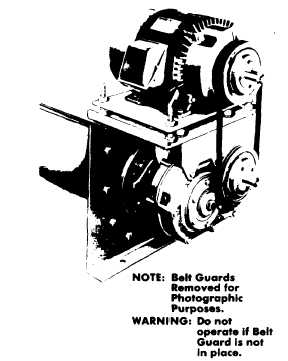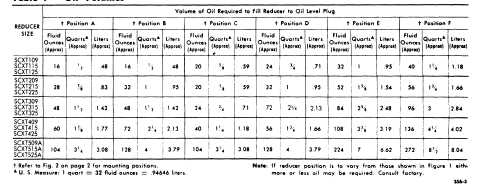TM 5-3895-374-24-2
Note: If motor mount, motor and sheaves are to be
installed
on
reducer
before
mounting
Screw
Conveyor Drive to trough end, bypass step 2;
perform steps 3 and 4, and then return to step 2.
2. On sizes SCXT3, SCXT4, and SCXT5A use lifting tab
to hoist the Screw Conveyor Drive into position. Slide
shaft into screw and adapter over trough end studs.
Only one set of adapter holes will fit over trough end
studs. If the mounted position of the Screw Conveyor
Drive varies by 15’ from any of the four horizontal
mounting positions shown in fig. 2, an incorrect set of
holes has been selected for coupling adapter to reducer.
This can be corrected by removing adapter screws and
rotating reducer to its proper position. Reinstall and
tighten adapter screws to torque specified in table 3 on
page 5. Install lockwashers and tighten nuts on trough
end studs. Attach drive shaft to screw.
3. Remove the three bolts from reducer housing
required for mounting the SCD Motor Mount. Place the
motor mount in position and install the three housing
bolts supplied with the motor mount. Tighten bolts to
torque specified in table 3 on page 5.
4. Install motor, drive sheave and driven sheave so that
driven sheave is as close to the reducer housing as
practical. Install V-belt and tension with the four
adjusting screws provided on the SCD Motor Mount.
Install Belt Guard. Make required electrical connections
for motor.
5. Because reducer is shipped without oil, it is necessary
to add the proper amount before operating the drive.
Use a high grade petroleum base, rust and oxidation
inhibited (R & O) gear oil-see lubrication tables.
6. Retighten bolts and pipe plugs after a few days
operation This prevents oil leakage.
Fig. 3-Complete Drive.
LUBRICATION
Under average industrial operating conditions, the
lubricant should be changed every 2500 hours of
operation or every 6 months, whichever occurs first.
Drain reducer and flush with kerosene, clean magnetic
drain plug and refill to proper level with new lubricant.
Caution: Too much oil will cause overheating and too
little will result in gear failure. Check oil level regularly.
Under extreme operating conditions, such as rapid
rise and fall of temperatures, dust, dirt, chemical
particles, chemical fumes or oil sump temperatures
above 200’ F, the oil should be changed every 1 to 3
months depending on severity of conditions.
NOTE:
Pour point of lubricant selected should be at
least 10’ F lower than expected minimum ambient
starting temperature.
Extreme
pressure
(EP)
lubricants
are
not
recommended for average operating conditions.
Special lubricants may be required for food and
drug industry applications where incidental contact
with the product being manufactured may occur.
Consult a lubrication manufacturers’ representative
for his recommendations.
Table 1-Oil Volumes.
page 3-782



